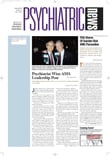It’s been a long time coming, but months of hard work by APA’s Council on Member and District Branch Relations and staff will pay off shortly when APA launches its totally revamped Web site this fall.
What members will find is a far more attractive, graphically oriented Web site with easy-to-navigate features—many of which are new—that will provide breaking news of interest to psychiatrists, information on the practice of psychiatry and advocacy, and programs that offer continuing medical education credit.
“We set out to create a site that is vibrant and easy to maneuver,” said Michael Vergare, M.D., chair of the Council on Member and District Branch Relations and vibrant. “Members should be able to scan the latest news quickly and decide what interests them most. For those trying to access APA resources or support, the icons for these functions will jump out. Most of the complaints I have heard about the old site—some of them my own—centered on how cumbersome it was to find what you needed.”
APA Medical Director James H. Scully Jr., M.D., commented, “Our commitment here at APA is to continue to improve our service to our members every day. This new Web site is an important step along the way.”
“APA’s Web site is the front door of our Association,” said Laurie Oseran, director of APA’s Division of Communications and Marketing.
One of the goals of the redesign was to make the content more timely by including breaking news on research and clinical developments, as well as on developments that impact on the practice of psychiatry and its patients.
“The site will be continually updated,” said Vergare. “In fact, I expect it to serve as a news resource that can get information out immediately.”
Under “Advocacy,” members will find up-to-the-minute information on legislation, “Action Alerts” that let members know when their efforts are needed to contact legislators about a particular bill or issue, and information on government regulations that affect the practice of psychiatry, such as the HIPAA privacy rule.
To help users move quickly from one part of the Web site to another is a “navigation box” on the left side of each Web page. The box lists the Web site’s major sections, many of which are new, including “District Branches and State Societies,” which will link members to the Web sites of their home societies; “Career Corner,” which will provide news and information to help psychiatrists advance in their careers, and “Calendar,” which lists the dates of APA meetings, along with the meetings of other major psychiatric organizations.
The new site will include more features and information accessible to members only. A recently updated APA membership directory will help members locate one another and make referrals. There are also improved links to other professional and subspecialty organizations of interest to psychiatrists, said Vergare.
Another improvement to the Web site is a new search engine that is vastly superior to the current one. As content is added to the Web site, it is assigned keywords that categorize the information. When the search engine performs a search, it uses these keywords along with its own independent analysis to provide more accurate search results.
To ensure that information is posted and removed in a timely manner, the content “will be put back in the hands of the APA staff and members who develop it,” said Oseran. Thus, staff will have the capability to add, delete, or update content. Moreover, the Division of Communications and Marketing has developed a style manual to ensure that all content is edited following the same rules and that the look of each document is consistent with the rest of the site.
APA’s Web site was first launched in 1996. Over the course of about a year, APA staff compiled and arranged the site’s content. While the site was innovative at the time and made many of APA’s informational resources and publications accessible to APA members, the site has not undergone a major overhaul until now.
In addition to Vergare, the members of the Council on Membership and District Branch Relations are Nioaka Campbell, M.D., John Gaston, M.D., Ellen Haller, M.D., Mary Marrocco, M.D., William Matuzas, M.D., Rekha Ranade-Kapur, M.D., Sarah Spratt, M.D., Margo Adams, M.D., Robin Huffman, M.D., Helen Montague Foster, M.D., and Priscilla Ray, M.D.
APA’s revamped Web site at www.psych.org goes live this fall. More information will be published closer to the launch date. ▪

